Columnaris disease troublesome for freshwater fish culture
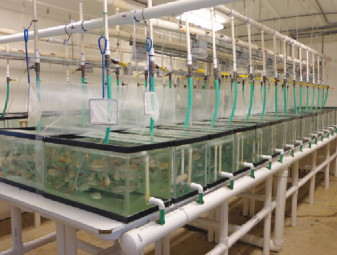
Trichodina are ciliated protozoan parasites of fish commonly found on the skin and gills. Fry and fingerling fish are especially susceptible to parasitism by Trichodina. Trichodina causes irritation by feeding on the epithelial layers of cells covering the surfaces of the skin and gills of the fish. Trichodina can cause serious pathological changes and mortalities among heavily parasitized fish. High numbers of Trichodina on fish can result in abrasion with the development of lesions and ulcers that allow secondary bacterial infections to develop.
Flavobacterium columnare, a Gram-negative rod bacterium, is the causative agent of columnaris disease. It frequently causes high mortality in many commercially important freshwater fish worldwide, including tilapia. Columnaris affects all life stages, from newly hatched fry to fish that have reached market size. Columnaris is generally regarded as an external infection of fish with clinical signs of skin lesions, fin erosion and gill necrosis.
Concurrent disease
Parasites and bacteria are common inhabitants in water at fish farms. Studies of parasite-bacteria interactions have showed that concurrent infections increase the severity of some infectious diseases, especially bacterial diseases.
In a previous report, tilapia infected with high numbers of Trichodina at a recirculation production facility had skin injuries that led to bacterial streptococcosis and edwarsiellosis that could not be controlled by antibiotics. Control of the parasite with formalin resulted in a decrease in overall deaths.
Treatment study
Building on this, the authors performed a study to evaluate whether treatment of Trichodina-parasitized tilapia with formalin would reduce F. columnare infection in fish and ultimately result in improved fish survival.
Sex-reversed hybrid tilapia of about 10-cm length reared in three, 340-L indoor tanks at the Aquatic Animal Health Research Unit of the U.S. Department of Agriculture’s Agricultural Research Service in Auburn, Ala., were found to be parasitized with Trichodina on both skin and gills. The infection intensity was measured at 4 to 8 Trichodina within a single 100-time magnification view under a microscope.
Flavobacterium columnare was isolated from a diseased channel catfish from Alabama. The isolate was inoculated in broth and incubated aerobically at 28 degrees-C. Following 24 hours of growth, the concentration of the bacterium was determined by bacterial plate count.
Parasite treatment
A total of 390 hybrid tilapia were divided into three groups. One group received no parasite treatment. The second group was treated in a single water bath with 150 mg/L formalin for one hour. The third was treated in a water bath with 150 mg/L formalin for one hour on two consecutive days. The fish were allowed to recover for five days after the treatments.
Ten fish were sampled from each group to enumerate their parasite loads and verify the fish were not infected with F. columnare using real-time polymerase chain reaction (qPCR). The fish were then divided into 18 tanks at 20 fish/tank for F. columnare challenge.
F. columnare challenge
Each group of fish from the formalin treatment phase was stocked in triplicate tanks. Half of each group was challenged via immersion in buckets of water with F. columnare at a concentration of 3.2 x 107 colony-forming units (CFU)/mL for 15 minutes. The remaining fish were not exposed to the bacteria, but kept in water with the same amount of Shieh broth for the same duration.
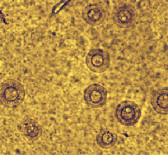
Two fish were randomly sampled from each tank one and three days after the F. columnare exposure. To evaluate Trichodina infection, wet-mount samples of skin and gill filaments were observed under a microscope.
Gill, liver and kidney tissues of about 20 mg were then collected from two fish and macerated in a microcentrifuge tube for F. columnare quantification. DNA was extracted and purified using standard methods. qPCR testing was used to quantify the F. columnare in infected fish.
Results
Prior to the F. columnare challenge, no Trichodina was observed five days post parasite treatment on the skin and gills of fish that were treated twice with formalin (Table 1). The single formalin treatment significantly reduced parasite prevalence and intensity as compared to the untreated fish. All non-treated fish were infected by Trichodina at an intensity of 4-6 parasites/viewing area.
| No. of treatments | No. of fish | Infection prevalence (%) | Infection intensity |
|---|---|---|---|
| Prior to F. columnare challenge | |||
| 0 | 30 | 100 | 6.4 |
| 1 | 30 | 20 | 0.3 |
| 2 | 30 | 0 | 0 |
| One day after F. columnare challenge | |||
| 0 | 18 | 100 | 3.7 |
| 1 | 18 | 22 | 0.2 |
| 2 | 18 | 0 | 0 |
After exposure to F. columnare, the untreated tilapia parasitized by Trichodina showed 37.5 percent mortality, while mortality for those treated with formalin was 16.7 percent or less (Table 2). Tilapia treated twice experienced 6.4 percent mortality. No mortality was observed in the parasitized tilapia that were not challenged with F. columnare.
| No. of treatments | F. columnare challenge | No. of fish | No. of dead | Mortality (%) |
|---|---|---|---|---|
| 0 | Yes | 48 | 18 | 37.5 |
| 1 | Yes | 48 | 8 | 16.7 |
| 2 | Yes | 48 | 3 | 6.3 |
| 0 | No | 48 | 0 | 0 |
| 1 | No | 48 | 0 | 0 |
| 2 | No | 48 | 0 | 0 |
One day after exposure to F. columnare, the parasitized fish without treatment showed significantly higher numbers of F. columnare in their gills compared to those treated with formalin (Table 3). The bacterial load was 27,075 genome copies (G.C.)/mg in the gills of parasitized fish without treatment – 12-fold higher than those treated once with formalin (2,250 G.C./mg) or 39-fold higher than those treated twice with formalin (699 G.C./mg).
| Tissue | Treatment | G.C./mg |
|---|---|---|
| Gill | 0 | 27.075 |
| 1 | 2,250 | |
| 2 | 699 | |
| Kidney | 0 | 207 |
| 1 | 88 | |
| 2 | 0 | |
| Liver | 0 | 266 |
| 1 | 127 | |
| 2 | 0 |
The parasitized fish without treatment also showed higher bacterial numbers in kidney and liver tissue than those treated with formalin, with concentrations of 207 and 266 G.C./mg, respectively.
Fish treated once with formalin had bacterial concentrations of 88 G.C./mg in kidney tissue and 127 G.C./mg in liver tissue. No F. columnare was detected in kidney and liver of fish treated twice.
Perspectives
Trichodina are transmitted by fish-to-fish contact and/or contaminated water. Improving water quality could be effective in reducing parasite infections in farmed fish. When fish parasites are detected in pond fish, treatment may be considered if the parasites are treatable, and treatments are economically feasible. Early detection and treatment may prevent heavy parasite loads on fish and limit the spread of parasites to fish in other tanks or ponds.
Parasite infections can disrupt the first line of defense in the skin and gills of fish, thereby creating portals of entry for bacterial pathogens. The formalin treatment of Trichodina-parasitized fish reduced bacterial invasion and ultimately improved fish survival.
This work suggested that prevention and treatment of parasite infections in fish are important parts of fish health management that not only reduce the direct damage caused by parasites, but also reduce fish mortality due to secondary bacterial infection.
Authors
-
De-Hai Xu, Ph.D.
USDA Agricultural Research Service
Aquatic Animal Health Research Unit
990 Wire Road
Auburn, AL 36832
USA[118,111,103,46,97,100,115,117,46,115,114,97,64,117,120,46,105,97,104,101,100]
-
Craig Shoemaker, Ph.D.; Dunhua Zhang, Ph.D.
USDA Agricultural Research Service
Aquatic Animal Health Research Unit
Tagged With
Related Posts
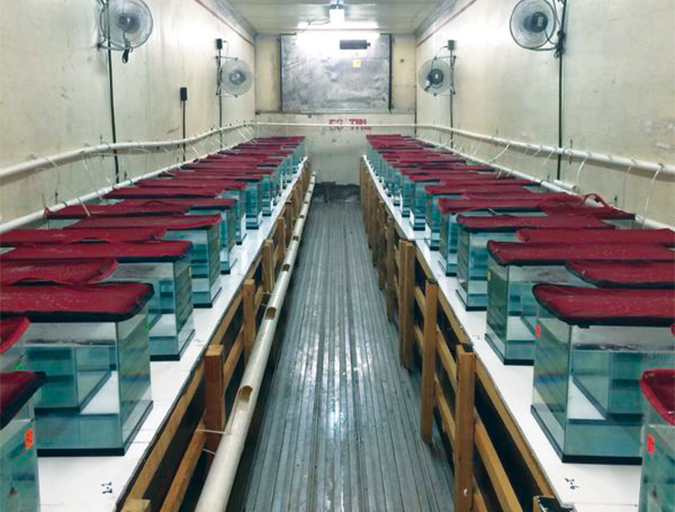
Health & Welfare
Genetic variation for resistance to WSS, AHPND in Pacific white shrimp
Selection for disease resistance has been used in breeding farm animals and can be a viable option to deal with white spot syndrome and acute hepatopancreatic necrosis disease in commercial shrimp culture. In trials, heritability for AHPND resistance was low, while that for WSS was moderate.
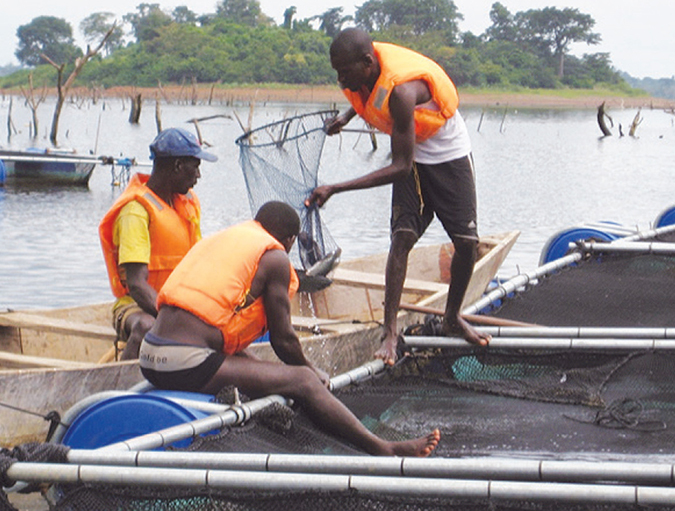
Innovation & Investment
Large-scale tilapia project driving aquaculture development in Ivory Coast
A large-scale aquaculture project in Ivory Coast, with "soft technology" adopted by Societe d’Elevage et de Distribution de Poissons, allows the full growing cycle to be controlled using local materials, manpower and inputs.

Health & Welfare
Parasitism enhances tilapia susceptibility to Flavobacterium columnare
The bacterium Flavobacterium columnare and parasite Ichthyophthirius multifiliis (Ich) are common pathogens that can cause heavy economic losses for fish culture. The authors conducted a study to evaluate the susceptibility of hybrid tilapia to F. columnare, including fish mortality and bacterial numbers in fish after parasitism by Ich.
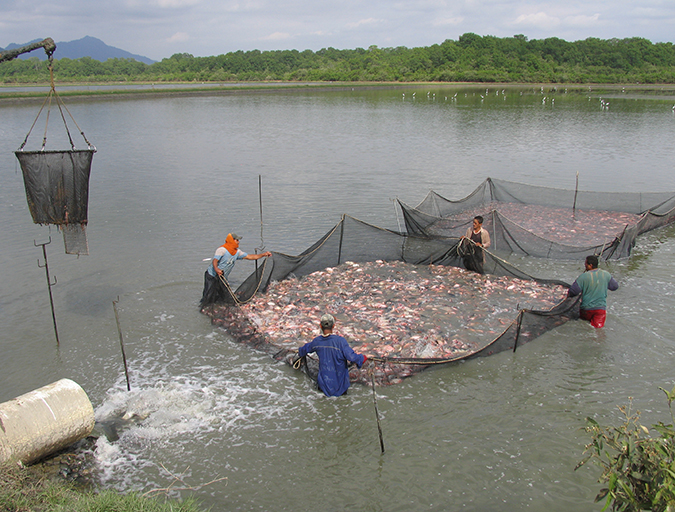
Responsibility
Addressing safety in Latin America’s tilapia supply chain
Over the last decade, the experience gained by many tilapia farmers combined with proficient programs implemented by local governments have significantly improved tilapia production in various Latin American countries like Colombia, Mexico, Ecuador and other important tilapia producers in the region.


